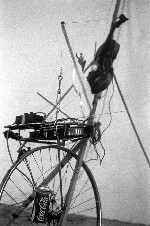 | |||||||

|
Violin Sound Exhibits |
|
|
Jon Rose: Fringe Benefits, 1977-1985 (Entropy Stereo Recordings, PO Box 4412, Ann Arbor, MI 48106-4412, USA, web: Entropy Stereo Recordings) In his publications 'The Pink Violin' and 'Violin Music in the Age of Shopping' (see the reviews section of MW 65, summer 1996) the Australian violinist Jon Rose printed sketches and pictures of instruments he dissected and transmogrified as part of his life long exorcising work on that demon queen of music, the violin. The specimens in Rose's Chamber of Horrors included a violin on wheels with three necks, a 10-string Siamese violin, a 19-string cello, and a violin with a built-in loudspeaker cone. These musical ghouls were hatched in the darker recesses of an imagination that must be a grinning cross between Bosch and Frankenstein. The images always made me curious as to how these extended violins would sound. Rose's albums of the last ten years did not give a clear indication of this. On these he uses virtual extensions of the basic instrument rather than physical deviations from it. His double album Fringe Benefits, named after the label on which he released recordings of his music in the '70s and '80s, documents the cutting edge experimentations Rose performed upon the violin and its derivatives during that period. The first thing that struck me when hearing it, was how far removed it seems to be from the majority of his later recorded work, which consists of tightly organised narratives in which the violin is presented in a multifaceted historical perspective. On Fringe Benefits there is no story line, and most of the music is improvised. An important difference is the fact that most of the music was recorded live, with little or no post-production in the studio; in his violin stories electronic treatment is an essential element of the composition process. On another level, however, you can't escape the similarities in the music from these two periods. There is the same anarchic sense of humour, exemplified to perfection by a twelve second recording of Rose duetting with a fly buzzing around in the body of his instrument. Another aspect that has not changed is the way in which he makes the context a part of the music, as can be heard in a recording of the 'Sydney Airport project' he did with Rik Rue. They spent a day at one of the runways, capturing the sounds of Rose's amplified violin and of passing aircraft on a recorder with an automatic input level setting - giving the listener the sensation of diving by the ears. The violin goes under playing when a plane approaches to re-emerge after it has passed, still playing as if nothing has happened. This album covers more than the exploits of Rose alone - it is also a document of the things the Australian improvisation scene was up to in that period. There are some stunning pieces with Simone de Haan whose extended techniques of trombone playing blur the boundary between the lips and the mouthpiece. There's Louis (Burdett's?) self-built instrument, The Hulk, so huge that it could be climbed on and fallen down from. The spirited performances of the various groups Rose used to play in bears testimony as to how wild and vibrant that scene actually was. Apart from these you will encounter a wide diversity of violin related species, from a half sized specimen that doubles as a triggering device for a Theremin to the gigantic amphibian 'Tromba Mariner', which latter growls quite like a humpback whale, oddly enough. The album is an astonishing showcase of possible constructions and techniques, and of the sounds that Rose accomplishes through these means. It does make clear that, however whimsical all these instruments may seem, there was a musical reason for building them. The 19 string violin on the second track, for instance, gives Rose a wide range of possibilities - he can play low grumbling notes next to melodies in the higher registers, he can get his bow, hands and fingers to work on any selection of strings, apply sound effects devices to them at will, and trigger howling feedback. The thing is still a violin, but in a very extended sense. A bit further down the road he can be heard plucking at an instrument against a background of gently lapping waves and the piercing buzz of cicadas. He plays his virtuosic lines with ease under just any circumstances, no matter whether they be sizzling heat, knee deep surf, a cattle train, a schmaltzy band or feedback generated by a microphone attached to his leg. With seventy cuts, many of which about a minute long (or even less than that), this double album is an audio version of a museum, where you are guided along the exhibits by the curator. A great collection, which often makes me wish that excerpts had been longer. For that one should probably turn to his duo album with koto player Miya Masaoka out on the Hong Kong Label, Sonic Factory. René van Peer |
 |
